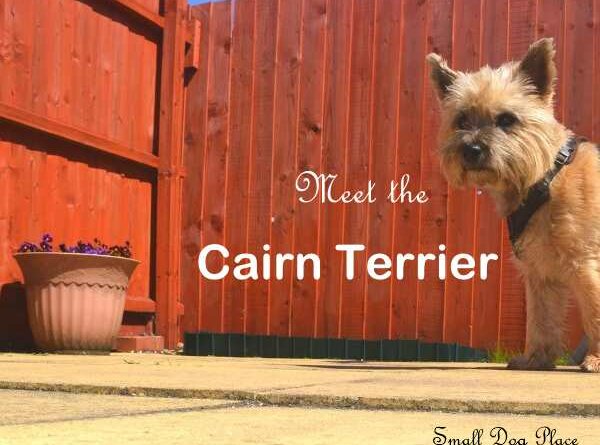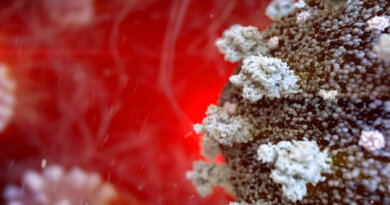Cairn Terrier (Complete Breed Profile and Pictures)
By Janice Jones | Last Updated 11-24-2021
The Cairn terrier is a confident, independent dog full of loyalty to his people, but friendly to all he meets.
His adaptability has allowed him to share the home of urban apartment dwellers, rural farm folks and everything in between.
First brought to the public’s attention in 1939 with the release of the Wizard of Oz, little Toto charmed children and adults alike.
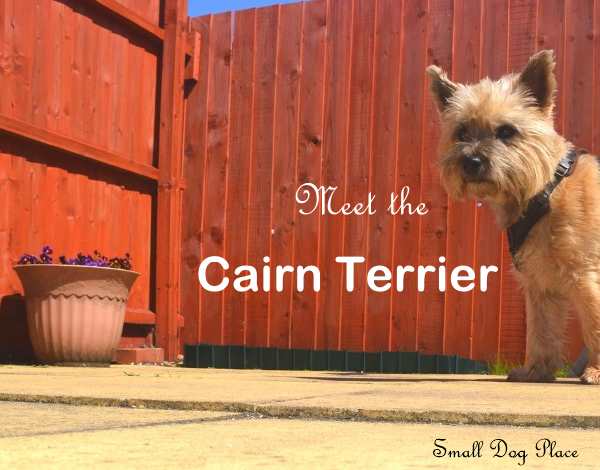
This little
dog has strong nails, muscular shoulders, strong jaws, and large feet, all of
which can create a dog that is perfect for routing vermin, which of course is
why the breed was developed originally.
Today,
the Cairn terrier participates in Confirmation, Agility, Tracking and terrier
trials. With good exercise and training,
a Cairn terrier can make a delightful pet for an individual, couple, or
family.
If you are looking for a warm spirited,
independent, happy dog that is great with children, this might be the breed for
you.
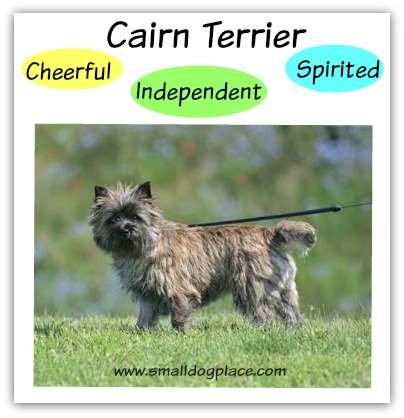
Quick Facts
Affiliation: AKC Terrier 2012 ranked 63
Size
Height:
9 to 13 inches
Weight 13 to 18 pounds
Coat Type:Harsh,
Wiry Outer Coat, Soft undercoat
Colors: Black, Black Brindle, Brindle, Cream, Cream
Brindle, Gray, Gray Brindle, Red, Red Brindle, Silver, Wheaten, Red Wheaten,
Silver Brindle, Silver Wheaten
Country of Origin: Scotland
Activity Level: Moderately active
Life Expectancy: 12 to 14 years
Good with Children: Yes
Good with other pets: Usually fine with other dogs; have been known
to attack cats and other small animals
History
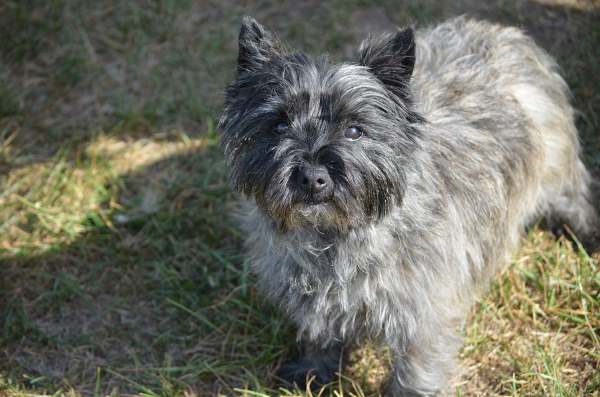
Historically,
the Cairn terrier belonged to a group of short-legged
terriers, bred on the Scottish Isle of Skye.
They were originally used to hunt otter, fox, and badger in the 15th
century, and were skilled in jumping at otters from piles of rocks or cairns, found
in the Scottish Highlands, thus the origin of their name.
These early terriers were bred for their
working ability, courage, determination and intelligence.
Over time, these terriers began to emerge
into distinct breeds. Prior to 1873, the
different terriers of Scotland were all grouped together and called Scotch
Terriers.
Then in 1873, two groups emerged: The Dandie Dinmont Terriers and the Skye
Terriers.
The Cairn was placed into the
Skye terrier grouping along with those dogs that would eventually become the
Scottish terrier and the West highland Terrier.
The three breeds were mainly differentiated by color, but at that point,
a terrier dam could have all three in the same litter.
These little terriers were called Short-Haired
Skye’s, and were kept to rid farmers of vermin and hunt foxes and otters.
By the early 20th century, they
began to be exhibited at dog shows and then in 1912, they were given the name,
Cairn terrier and then recognized by the American Kennel Club in 1913.
Prior to that date, it was not uncommon for
Cairns to be mated with Westies.
In 2009, the Cairn Terrier ranks 56rd among dog breeds registered by the AKC.
By 2014, their popularity had dropped to 67th most popular dog in America.
Cairn Terriers At a Glance
Dog Breed Ratings Got You a Little Confused?
Here’s a little help in understanding them
- Playfulness: Most Playful = 5 Least Playful = 1
- Affection: Most Affectionate = 5 Least Affectionate = 1
- Friendliness Towards Strangers: Most Friendly = 5 Least = 1
- Good With Children: Great= 5 Not Good with Children = 1
- Good With Dogs: Great = 5 Not Good Around Dogs = 1
- Good With First Time Owners: Fine=5 Not Appropriate = 1
- Exercise Required: Extensive Daily Exercise = 1 Minimal = 1
- Ease of Training: Very Easy = 5 Difficult = 1
- Watch Dog: Excellent Watch Dog = 5 Minimal = 1
- Grooming: Time Consuming = 5 Minimal = 1
- Shedding: Heavy Shedder = 5 Minimal = 1
- Cold Tolerance: Well Tolerated = 5 Poor Tolerance = 1
- Heat Tolerance: Well Tolerated = 5 Poor Tolerance = 1
Personality
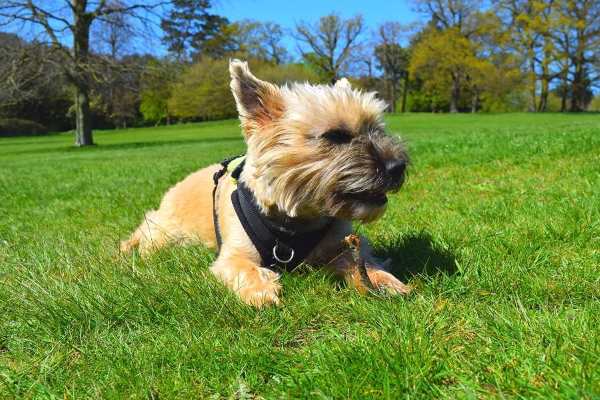
Just think about Toto from the Wizard of Oz, and you will
get an immediate feel for this feisty, fearless assertive little dog. Your Cairn may not need to escape from the
Wicked Witch of the West, but he’ll have all the tenacity and boldness if the occasion
ever arose.
They are inquisitive,
intelligent and a bit mischievous in a fun sort of way. They do love to dig, which is one of those
traits that have been bred into them for generations.
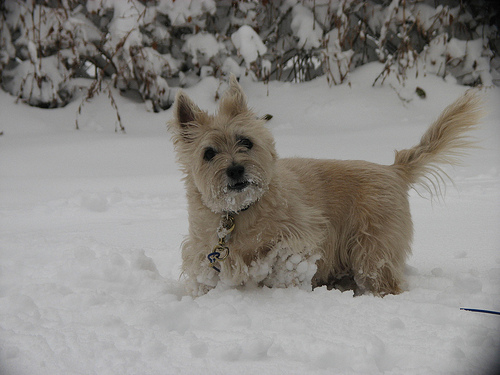
While not considered problem barkers, they will
bark to alert their owner of visitors or even if just bored or lonely.
They prefer the company of humans and demand
attention and affection.
These dogs are very people oriented and super friendly but
will defend their territory with courage if need be.
Your Cairn may not need to escape
from the
Wicked Witch of the West,
but he’ll have all the tenacity and boldness
if the occasion
ever arose.
They do well with other dogs, generally, but
may not be the perfect pet if there is already a cat in the home. Small rodents such as guinea pigs and
hamsters, seem more like vermin to a Cairn than another household pet, so if
both live under the same roof, precautions should be taken.
Cairn Terriers do well with children who are gentle and
know how to treat a dog. They are the
perfect size, small enough not to frighten a young child, yet not so delicate
that they can’t withstand a little rough and tumble play.
They will take long walks, play fetch, or only
run at top speeds around the yard or house if you let them.
You need not worry about these dogs getting
old and sedentary as many have been known to remain energetic and spirited well
into their teen years.
The best type of owners for a Cairn terrier will be one who
is willing to train and provide the exercise and stimulation that these dogs
crave. Cairn terriers are intelligent and will learn quickly, but might decide
to test the limits.
Firm, positive approaches
work well with these dogs. They do best
with owners who are consistent and make it clear who is in charge.
Digging can be a problem; so precautions must be made to
protect valuable gardens. Walking on a leash is a must. The prey drive is strong in this breed and a
stray squirrel might be all it takes for your Cairn to take off to parts
unknown.
Cairn terriers do best as
indoor dogs, but when left to romp and play outdoors, a securely fenced yard is
highly advisable. Supervision is
important too because with the Cairn’s keen ability to dig; a hole can be
created for the great escape in a very short period of time.
Grooming
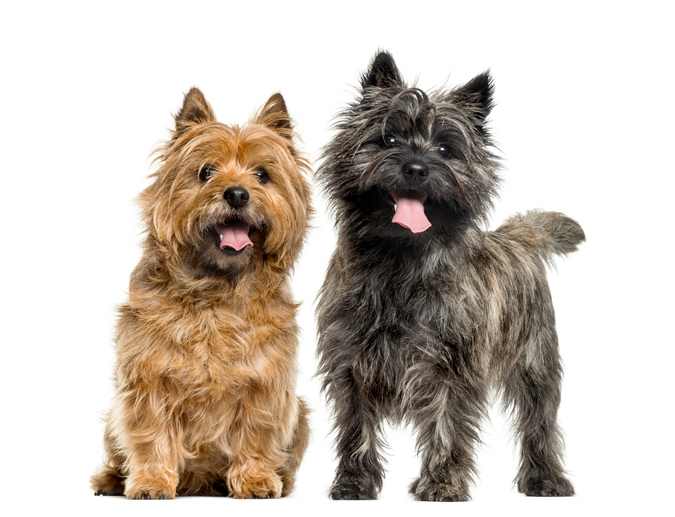
The coat of the Cairn terrier comes in a variety of colors and is weather resistant comprising two layers: a thick harsh outer coat and a soft undercoat.
Their wire haired coat keeps the dog dry in rainy weather, and if maintained, the skin can remain healthy, and the outer coat will continue to protect the dog from the elements.
They shed very little so, to remove old dead hairs, hand stripping is recommended a couple times a year.
Stripping,
using a stripping knife or comb removes the dead hair at the roots and
allows new hair to grown in. Clipping the coat is not recommended.
Brushing and combing the coat is the predominant grooming task and most important one to keeping the coat clean and odor free, keep shedding to a minimum and assuring the dog maintains a healthy skin.
Brushing should be done weekly.
Bathing is recommended very infrequently as this tends to dry out the coat, cause breakage and actually attract dirt.
An alternative to bathing is to place rubbing alcohol in a spray bottle and mist the coat. Next rub the entire coat with a towel and then brush.
If the dog is very smelly or dirty and the dirt cannot be brushed out a bath may be in order using a shampoo for harsh coats. No cream rinse is recommended.
The Cairn’s nails will need to be trimmed when long and then filed to achieve a smooth surface.
Teeth should be brushed regularly and as often is possible. Daily would be ideal but may not be practical for every dog owner.
The Cairn’s eyes should be wiped with a soft cotton ball and saline solution to remove any debris or crusty build up from the tear ducts. This is usually done daily.
A fine stripping knife is used to groom the ears. Hair on the ears can grow and begin to look shaggy. Removing some of these hairs help the dogs look neater. Pull only the top 1/3 of hair on both sides of each ear.
This results in a nice clean appearance that adds to the charm of the Cairn’s already cute face. The inside of the ears will need to be cleaned out periodically using an ear cleaning solution and cotton ball.
If you notice redness or a foul odor, it’s time for a vet visit.
Health Concerns
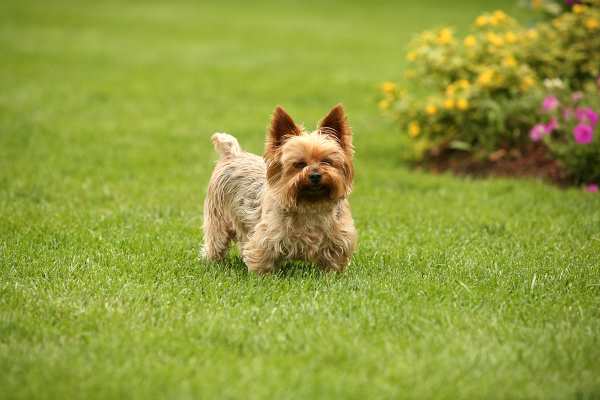
The Cairn terrier enjoys an average lifespan of 12 to 14 years and is a relatively healthy breed.
As with other small dog breed dogs there are
certain inherited conditions have been reported to occur occasionally. According to the Cairn Terrier Club of America, the following problems have been identified in the breed:
Ocular melanosis
CraniomandibularOsteopathy
Cryptorchidism
Liver Portosystemic Vascular Anomaly and Microvascular Dysplasia
Globoid Cell Leukodystrophy (GCL)
Heart Defects
Renal Dysplasia
Hypothyroidism
Scottie Cramp
This sounds like a very long list and might imply that Cairn Terriers are very unhealthy. That is not the case and the chance that your dog could be affected by one of these issues is small.
What this list does tell us is that the parent club is very conscientious and take health problems seriously. They encourage breeders to get breeding stock tested wherever feasible
Hip Dysplasia
A genetic condition with environmental components that can cause pain, inflammation and lameness in dogs.
Click here to read more about Hip Dysplasia in small breed dogs.
Craniomandibular Osteopathy
Craniomandibular Osteopathy, which is also known
as lion jaw, is a non-cancerous bone growth which occurs on the lower jaw and
long bones of the leg.
The symptoms
begin around four months of age and often resolve themselves as the puppy
reaches his first birthday.
They can be as mild as refusing food for a day or
two or as severe as pain and the inability to open the mouth. An X-ray will diagnose the problem and treatment
usually consists of administering aspirin or steroids.
This is an inherited disorder which involves a Single
autosomal recessive gene.
Globoid Cell Keukodystrophy (GCL)
Krabbe’s disease as it is also called
is a degenerative disease of the white matter of the brain and spinal cord. If
a puppy is born with this condition, he is likely to die very young or will
need to be euthanized.
It is inherited
by a single autosomal recessive gene, but there is a test available now that
allows breeders to identify carriers of the disease.
Legg Calve Perthes Disease
Legg-Perthes affects the head of the femur
(leg bone) and occurs in many small breed dogs.
It is diagnosed by X-ray and surgery can correct the problem.Click here to read more about Legg Calve Perthes Diease.
Luxated Patella
This is a problem in many small breeds
of dogs, including the Cairn terrier. In
this disease, the knee cap slips out of the groove.
It is an inherited disease
in most breeds and can be diagnosed by X-ray and a veterinarian palpating the
knees.
The severity of the condition can
vary from very mild to severe requiring corrective surgery.
Read more about Luxating Patella Issues
Ocular Melanosis/Secondary Glaucoma
An inherited disease that affects
Cairns, the first known cases of this disorder was diagnosed in the United
States in 1984.
The condition affects
both eyes usually with an onset of around 7 to 12 years of age. As the disorder
progresses, pigment deposits can be seen in the anterior chambers of the eyes
which decrease the eyes’ ability to drain fluid.
The fluid accumulates, increasing the
pressure in the eye or secondary glaucoma.
If untreated, pain and blindness
results. If caught early medication can
slow the process, but if caught late, the eye may need to be removed.
Progressive Retinal Atrophy (PRA)
Also known as PRA, this disorder
affects a dog’s vision at night and then progresses to dim light
conditions.
Eventually, the dog becomes
completely blind. This is an inherited disease.
Read more about Progressive Retinal Atrophy
Renal Dysplasia
Renal dysplasia is common in many small
breed dogs and is an inherited disease described as an abnormal development of
the kidney occurring even before the puppy is born.
With incomplete kidney tissue, the kidney is
not able to function properly and leads to death at an early age.
Symptoms include increased urination,
increased drinking, vomiting, lethargy, loss of appetite, and weight loss.
Pros
- Friendly, family dog
- Good with Children
- Minimal Grooming
- Good Exercise partner
Cons
- May not do well in homes with cats or
small rodents - Requires exercise and training
- Likes to dig-should not be left in
areas where he’s likely to dig - Strong prey drive-should remain on
leash at all times
Reference and Further Reading
I always encourage anyone interested in adopting a dog to do as much research as possible before the big day.
If you think the Cairn Terrier might be the ideal breed for you, consider reading one of the books below.
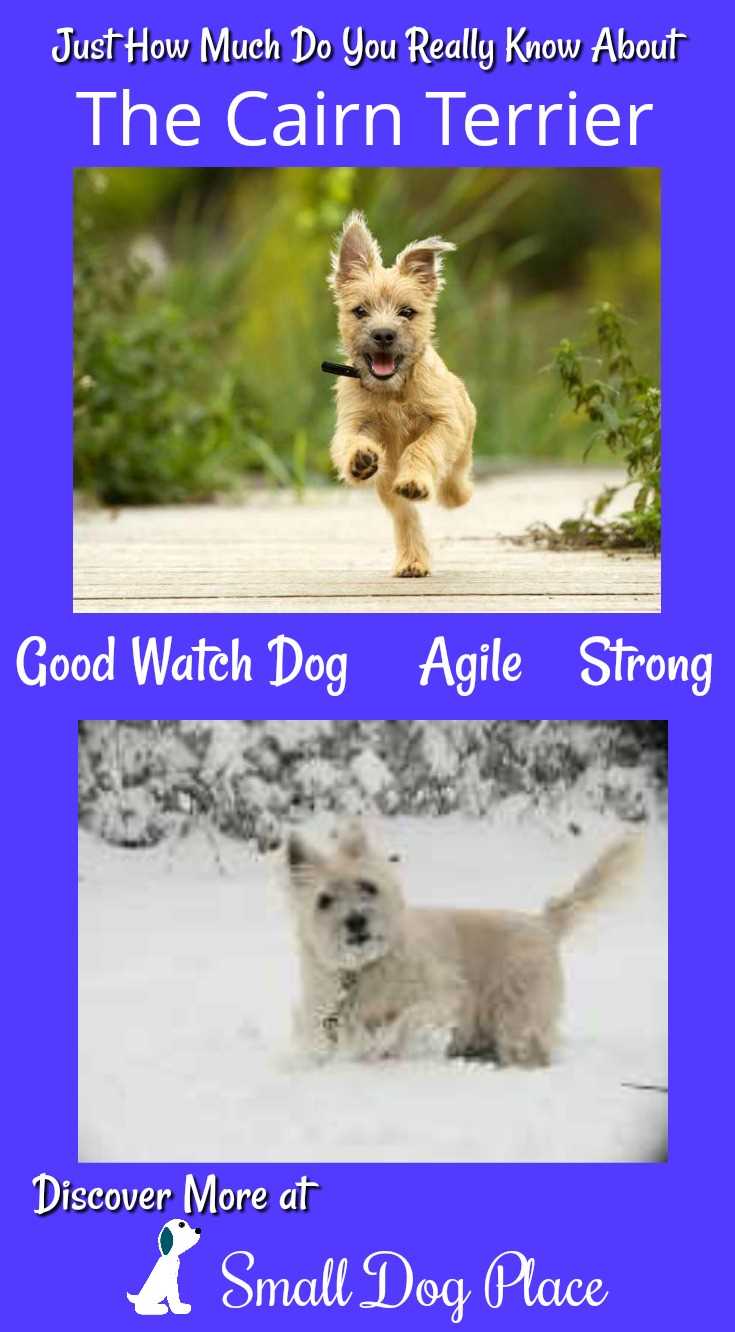
Does This Article Deserve Your Thumbs Up?
We always appreciate your support and encouragement. Your thumbs up means so much to us. Please like this article.
If you find this page or any page on Small Dog Place Helpful, or Useful in anyway, I’d love it if you would click the small heart found on the bottom right of each page.
You can also share or bookmark this page — just click on the:

Free Monthly Newsletter
Sign Up for Our Free Newsletter and get our Free Gift to You.
my E-book, The Top 10 Mistakes People Make When Choosing a Dog (and how to avoid them)

